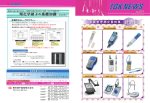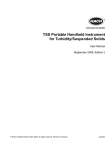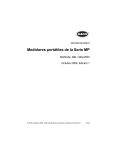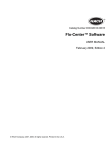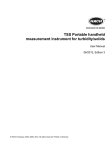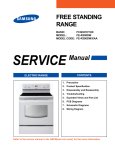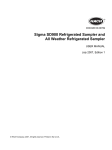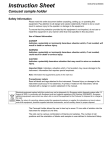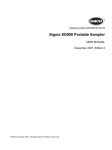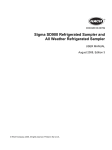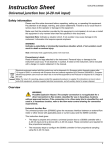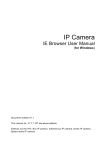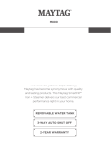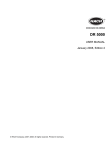Download Waterproof Handheld H160 and H170
Transcript
DOC022.53.80058 Waterproof Handheld H160 and H170 USER MANUAL September 2009, Edition 1 © Hach Company, 2009. All rights reserved. Printed in The U.S.A Table of Contents Section 1 Specifications .................................................................................. 3 Section 2 General information ....................................................................... 5 2.1 Safety information ....................................................................................... 5 2.1.1 Use of hazard information ................................................................ 5 2.1.2 Precautionary labels ......................................................................... 6 2.2 Overview ..................................................................................................... 6 Section 3 Installation ........................................................................................ 7 3.1 Probe connections ...................................................................................... 7 3.2 Probe connection installation ...................................................................... 8 3.2.1 Connect the glass pH or ORP .......................................................... 8 3.2.2 Connect the ISFET pH probe ........................................................... 8 3.2.3 Connect the conductivity probe ........................................................ 9 3.2.4 Phono jack for BNC probe temperature sensors .............................. 9 Section 4 Operation ........................................................................................ 11 4.1 Keypad description ................................................................................... 11 4.2 Display description .................................................................................... 13 4.3 Meter setup functions ............................................................................... 14 4.3.1 Set stabilization lock ON or OFF .................................................... 14 4.3.2 Set the temperature display ............................................................ 15 4.3.3 Turn the sound ON/OFF ................................................................. 16 4.3.4 Meter automatic shutoff time .......................................................... 17 4.3.5 Clearing calibration points .............................................................. 18 4.4 ERROR CODES ....................................................................................... 20 Section 5 pH Operations ............................................................................... 21 5.1 Set the pH options .................................................................................... 21 5.1.1 Set the pH resolution: 0.1 pH or 0.01 pH ........................................ 21 5.1.2 Set the 2 and 3 point pH calibration ............................................... 21 5.1.3 Set the pH calibration method ........................................................ 22 5.2 Set the manual temperature compensation for glass pH electrodes ........ 24 5.3 pH calibration ............................................................................................ 25 Section 6 Conductivity & TDS Operations .............................................. 29 6.1 Set the Conductivity options ..................................................................... 29 6.1.1 Set the conductivity calibration points ............................................. 29 6.1.2 Set the conductivity temperature .................................................... 29 6.1.3 Set the conductivity probe cell constant ......................................... 30 6.2 Set the TDS options .................................................................................. 31 6.2.1 Set the TDS conversion factor ........................................................ 31 6.2.2 Set TDS units ................................................................................. 32 6.2.3 Set salinity units: ppm (ppt) or % .................................................... 33 6.3 Conductivity and TDS calibration ............................................................. 33 Section 7 Maintenance .................................................................................. 37 7.1 ISFET pH probes maintenance ................................................................. 37 7.1.1 Calibrate and verify ......................................................................... 38 1 Table of Contents 7.2 ISFET non-glass probe maintenance ........................................................38 7.3 BNC electrode maintenance ......................................................................38 7.4 Probe cleaning ..........................................................................................39 7.4.1 ISFET non-glass probe cleaning and reconditioning .......................39 7.4.1.1 Cleaning the ISFET non-glass probes ..................................39 7.4.1.2 Recondition the ISFET non-glass probes ............................40 Section 8 Troubleshooting ............................................................................41 8.1 Error codes ................................................................................................41 8.1.1 Low battery indicator .......................................................................43 Section 9 Replacement parts and accessories ......................................45 9.1 Replacement parts ....................................................................................45 9.2 Accessories ...............................................................................................46 Section 10 Contact Information ...................................................................47 2 Section 1 Specifications Specifications are subject to change without notice. Meter specification Details Dimensions 3.5” W x 8” H x 2” D (90mm x 204mm x 50mm) Weight 3.0 lbs (1.3 Kg) Battery requirements 4-ANSI -ISA or IEC-LR6 (AA Alkaline) Power consumptions 1W backlight on Battery life Up to 200 continuous 10 hour advance of low battery warning Storage temperature -20 to +60 °C (4 to 140 °F) Operating temperature Maximum range between +45 to + 60°C (115 to 140 °F) Input connectors All models have built-in temperature connectors for sensors. The handheld series have ISFET (8-pin) connectors, BNC with phone jack temperature connectors, 12 pin conductivity connectors Languages English Temperature correction Off, automatic and manual (parameter dependent) Measurement Continuous measurement Protection rating IP67 pH Calibration Up to five points with automatic buffer recognition 1.68, 4.01, 6.86, 7.00, 9.18, 10.01, 12.45 Accuracy ±0.01 pH Resolution 0.01 pH Range 0.00 to 14.00 mV Calibration None Accuracy 0.1 mV Resolution Auto ranging 0.1 and 1 Range Auto ranging ± 199.9 mV to ± 1999 mV Temperature Calibration None Accuracy ±0.5 °C Resolution 0.1 °C 0.1 °F Range -0 to 100 °C (Display °C or °F) 3 Specifications Conductivity Calibration Up to five points Accuracy ± 1% full scale or ±1st digit Resolution 0.01 ìS, 0.1 ìS ,1 ìS, 0.01 mS, 0.1 mS Range Autoranging 0.00 to 19.99 ìS, 20.0 to 199.9 ìS, 200 to 1999 ìS, 2.00 to 19.99 mS, 20.0 to 199.9 mS TDS Calibration Up to five points Accuracy ± 1% full scale or ±1 digit Resolution 0.01 ppm, 0.1 ppm, 1 ppm, 0.01 ppt, 0.1 ppt, 1 ptt, 0.1 mg/l, 1 mg/l,0.01 g/l,0.1 g/l Range Autoranging: 0.00-9.99 ppm, 10.0-99.9 pm, 100-999 ppm,1.00-9.99 ppt,10.0-99.9 ppt, 100-200 ppt the meter will also display in mg/l: 0.00-199.9 mg/l, 200-1999 mg/l, 2.00-19.99 g/l, 20.0-50 g/l Salinity Calibration None (derived from conductivity) Accuracy ± 0.1 ppt (-2 to+35 °C) Resolution 0.1 ppt 1% Range 0-42 ppt 4 Section 2 General information In no event will the manufacturer be liable for direct, indirect, special, incidental or consequential damages resulting from any defect or omission in this manual. The manufacturer reserves the right to make changes in this manual and the products it describes at any time, without notices or obligation. Revised editions are found on the manufacturers website. 2.1 Safety information Please read this entire manual before unpacking, setting up, or operating this equipment. Pay attention to all danger and caution statements. Failure to do so could result in serious injury to the operator or damage to the equipment. Make sure that the protection provided by this equipment is not impaired, do not use or install this equipment in any manner other than that specified in this manual. 2.1.1 Use of hazard information DANGER Indicates a potentially or imminently hazardous situation which, if not avoided, will result in death or serious injury. WA R N I N G Indicates a potentially or imminently hazardous situation which, if not avoided, could result in death or serious injury. CAUTION Indicates a potentially hazardous situation which, if not avoided, could result in minor or moderate injury. NOTICE Indicates a situation that is not related to personal injury. 5 General information 2.1.2 Precautionary labels Read all labels and tags attached to the instrument. Personal injury or damage to the instrument could occur if not observed. This is the safety alert symbol. Obey all safety messages that follow this symbol to avoid potential injury. If on the instrument, refer to the instruction manual for operation or safety information. This symbol indicates that a risk of electrical shock and/or electrocution exists. Electrical equipment marked with this symbol may not be disposed of in European public disposal systems after 12 August of 2005. In conformity with European local and national regulations (EU Directive 2002/96/EC), European electrical equipment users must now return old or end-of life equipment to the Producer for disposal at no charge to the user. Note: For return for recycling, please contact the equipment producer or supplier for instructions on how to return end-of-life equipment, producer-supplied electrical accessories, and all auxiliary items for proper disposal. 2.2 Overview NOTICE Always turn off the meter when changing electrodes. If the meter is used in a manner other than as described, the performance of the meter can be impaired. The Waterproof Handheld meters are available in 2 models: • Waterproof handheld H160 and H170 • The meter automatically identifies which type of electrode is attached when the meter is turned on The H160 and H170 meters accept both traditional style glass pH with BNC connectors and non-glass pH probes with ISFET (Ion Sensitive Field Effect Transistor) silicon chip sensors. The meters are designed to use only one pH electrode (either a BNC pH electrode or an ISFET pH probe) at a time. The H170 multi-parameter meter accepts conductivity probes with different cell constants. The constant is automatically detected by the meter. Both pH and conductivity probes can be attached simultaneously to the H170 model meters. 6 Section 3 Installation 3.1 Probe connections Figure 1 Probe connection for the H160 1 BNC connector 3 ISFET pH probe connector 2 3.5 mm phono jack 4 Connector dust cap Figure 2 Probe connections for the H170 meter 1 Conductivity probe connector 4 ISFET pH probe connector 2 BNC connector 5 Connector dust cap 3 3.5 mm phono jack connector 7 Installation 3.2 Probe connection installation NOTICE The ISFET probe connector and conductivity probe connector are keyed differently to prevent attachment of a probe to the wrong connector. The meters are designed to use only one type of pH probe at a time. If the meter is submerged, and the rubber plug is not installed on the 3.5 mm phono jack, the interior of the jack may fill with water although the interior of the meter itself remains sealed. If the 3.5 mm phono jack is flooded, it must be dried immediately. It is best to invert the meter to allow any water to run out of the connector. 3.2.1 Connect the glass pH or ORP The meters accept glass pH, ORP, or with BNC connector. To connect the glass pH or ORP probe: 1. Always turn off the meter when the probe is changed. 2. Connect the pH glass probe to the BNC connector. 3. Connect a stand-alone temperature probe or an integrated temperature sensor from a glass pH electrode with the 3.5 mm phono jack connector and a BNC connector. 4. Refer to and to view the connections. 5. Turn the meter on. The meter will automatically identify the probe that is connected. 3.2.2 Connect the ISFET pH probe These meters accept two different types of pH sensor technologies, ISFET pH probes and glass electrodes. The meters automatically identify whether a glass or ISFET pH probe is attached when it is first turned on. Be sure that both the receptacle on the meter and the connector on the probe are clean and dry; wet or dirty connections may cause unstable indications. The meter is designed to use only one type of pH probe at a time. 1. Make sure the meter power is off. 2. Connect the ISFET probe to the ISFET pH probe connector 3. Refer to view the connectors. 4. Refer to view the connectors. 5. Power the meter on. The meter will automatically identify the probe that is connected. If the meter does not detect the presence of an ISFET probe, the meter defaults to a glass pH electrode mode and reads pH from the BNC connector. Refer to for error messages related to probe detection. 8 Installation 3.2.3 Connect the conductivity probe 1. Make sure the meter power is off. 2. Connect the conductivity probe to the meter. 3. Refer to view the connectors. 4. Power the meter on. The meter will automatically detect conductivity probe and cell constant of that probe. 3.2.4 Phono jack for BNC probe temperature sensors The temperature sensor for a BNC probe uses a 3.5 mm phono jack. When a temperature sensor is connected, the meter will Automatically Temperature Compensate (ATC) pH electrode indications. To connect the temperature sensor: 1. Always turn off the meter when a probe is changed. 2. Connect the BNC probe temperature sensor to the 3.5 mm phono jack or BNC connection 3. Both the H160 and H170 use a 3.5 mm phono jack connector and a BNC connector. Refer to Section 3 Installation on page 7 to view the connections. 4. Power the meter on. The meter will automatically identify the probe that is connected. 9 Installation 10 Section 4 Operation 4.1 Keypad description Refer to Figure 3 for keypad and key descriptions and functions. Figure 3 Model H170 shown Key Action H160 H170 Turn meter on and off • • Display pH • • Display mV • • Turns light on for two minutes • • Display TDS. If a conductivity probe is not attached, TDS mode is inactive. • Display conductivity. If a conductivity probe is not attached, conductivity mode is inactive • Display salinity. If a conductivity probe is not attached, salinity mode is inactive • 11 Operation Key Action H160 H170 HOLD mode. Readings are frozen until HOLD key is pressed again to release the display. Only operates in measurement modes. • • • Used to confirm values and begin calibration • • Scroll values when in calibration mode: View setup screens and set numeric values during setup • • Enter setup mode • • Confirm values to begin calibration and HOLD measurement indication 12 Operation 4.2 Display description The H160 and H170 Waterproof Handheld meters each display features in an LCD display as follows: Figure 4 LCD display and features Item No Description H160 H170 1 ISFET pH probe indicator • • 2 The meter is in the pH measurement mode • • 3 The meter is in the conductivity measurement mode • 4 The meter is in the salinity measurement mode • 5 The meter is in the TDS measurement mode • 13 Operation Item No Description H160 H170 6 TDS or salinity mode value is in mg/L or g/L • 7 TDS or salinity value is ppm • 8 TDS or salinity value is in ppt • 9 The displayed value is a mV value • • 10 The displayed value is a pH value • • 11 the conductivity value is in mS • 12 The conductivity value is in µS • 13 The salinity value is in % • 14 The pH, Conductivity, TDS or Salinity value is automatically temperature compensated. • 15 The meter is in a calibration mode and when calibrating it indicates the point of a multiple point calibration • • 16 The Temperature value is in °F • • 17 The Temperature value is in °C • • 18 Low power indicator • • 19 Meter is in setup mode • • 20 Temperature value • • 21 Main display value • • 22 Stable indication (endpoint) in pH, Conductivity, TDS or Salinity 23 The display is in HOLD mode • • • 4.3 Meter setup functions 4.3.1 Set stabilization lock ON or OFF pH, conductivity, TDS can be displayed with a stabilization lock mode. When a stable indication is reached, the display locks on the value and the meter ignores very slight changes in the measurement. The READY icon turns on when an endpoint is reached and the stabilization lock is active. The display automatically unlocks after a significant measurement change is detected. When performing titrations or attempting to detect very slight changes, the stabilization lock should be OFF. 14 Operation To set the stabilization lock: 1. Push the SETUP key to put in the setup mode. 2. Push ENTER. The display will show the stabilization lock status. 3. Use the arrows keys to set the stabilization lock mode to off or on. 4. Push ENTER to save changes and return to setup mode. 5. Push SETUP to return to setup mode without saving changes. 4.3.2 Set the temperature display Temperature can be displayed in ºC or ºF. The default mode is ºC. To select temperature units: 1. Push the SETUP key to put in the setup mode. 15 Operation 2. Push the arrow keys until the temperature units setup screen is displayed. 3. Push ENTER. The display will show the current units. 4. Use the arrow keys to set the temperature units. 5. Push ENTER to save changes and return to setup mode or push SETUP to cancel any changes and return to the setup mode. 4.3.3 Turn the sound ON/OFF Sounds will occur to alert the user. • Three short beeps: Any time measurement stability is reached during calibration mode, regardless of the stabilization lock setting. • One short beep: Stabilization is reached in stabilization lock ON mode. • Two long beeps: An error condition occurs. An error code will be displayed. To turn the sound on or off: 1. 16 Push the SETUP key to put in the setup mode. Operation 2. Push the arrow keys until the sound icon is displayed. 3. Push ENTER. The display will show the sound status (ON or OFF). 4. Use the arrow keys to display ON or OFF. 5. Push ENTER to save changes and return to setup mode. Push SETUP to return to setup mode without saving changes. Note: Pushing the arrow keys will display ON and OFF. 4.3.4 Meter automatic shutoff time The meter will shutoff automatically to conserve battery power after a predetermined period of time (default is 20 minutes). The meter will beep intermittently for one minute prior to shutdown. Auto power off is user selectable from one minute automatic shut down to always on. User must power cycle for the automatic shutoff to take effect. 17 Operation To change or set the meter shutoff time: 1. Push the SETUP key to put in the setup mode. 2. Push the arrow keys until the meter automatic shutoff time screen is displayed. 3. Push ENTER. The display will show the number of minutes until the meter automatically shuts off. 4. Use the numeric keypad or the arrow keys to set the shutoff time in minutes. Set to 000 for continuously on. 5. Push ENTER to save changes and return to setup mode. 6. Push SETUP to return to setup mode without saving changes. 4.3.5 Clearing calibration points It is possible to clear all stored calibration points for all parameters. It is important to recalibrate the meter prior to use after clearing all calibration points. To clear calibration points in the meter: 1. 18 Push the SETUP key to put in the setup mode. Operation 2. Push the arrow keys until the clear all calibration points screen is displayed. 3. Push ENTER. 4. The meter will prompt if the user wants to clear all calibration points. The default is No. 5. Push the arrow keys to display Yes and then Push ENTER to clear. 6. Push SETUP to return to setup mode without saving changes. Note: This procedure DOES NOT clear calibration data for an ISFET probe. 19 Operation 4.4 ERROR CODES NOTICE It is not recommended that the user override the error codes. It is not possible to override all error codes. Pushing the arrow keys will display the Yes and NO options. Some error codes, such as poor electrode condition, can be overridden by the user to allow the instrument to be used until a replacement electrode can be obtained. When an error is displayed, first check to determine the cause of the error. To abort the calibration or other error causing condition, Push SETUP or the pH COND/TDS/SAL) key. To override an error code (not recommended): 1. Push ENTER. 2. Push the up arrow for display to YES. This indicates the option to perform an error override. Push ENTER. Refer to section Section 8 on page 41 for troubleshooting error codes, causes and actions. 20 Section 5 pH Operations 5.1 Set the pH options 5.1.1 Set the pH resolution: 0.1 pH or 0.01 pH The pH can be displayed in two resolutions: 0.1 pH or 0.01 pH. The stabilization lock (READY icon) will occur faster at 0.1 pH resolution. To select the resolution: 1. Push SETUP then push PH to put the meter in the pH setup mode. 2. Push the arrow keys until the pH resolution setup screen is displayed. 3. Push ENTER. The display will show the pH resolution. Use the arrow keys to set the pH resolution between 0.01 and 0.1. 4. Push ENTER to save changes and return to setup mode. Push SETUP to return to setup mode without saving changes. 5. Push ENTER. The display will show the current number of calibration points. Use the arrow keys to set calibration points between 2 and 3. 5.1.2 Set the 2 and 3 point pH calibration The default calibration point is 2 point. To select the number of calibration points: 1. Push SETUP then push PH to put in the pH setup mode. 21 pH Operations 2. Push the arrow keys until the pH calibration point setup screen is displayed. Push ENTER. The display will show the current number of calibration points. Use the arrow keys to set the calibration points. 3. Push ENTER to save changes and return to setup mode. Push SETUP to return to setup mode without saving changes. 5.1.3 Set the pH calibration method The meter allows the user to define which pH buffers are to be used, and in which order. The default is a two point calibration pH 7.00 for the first point and pH 4.00 for the second point. To set the first point of a pH calibration method: 1. Push SETUP then push PH to put in the pH setup mode. 2. Push the arrow keys until the calibration method setup screen is displayed. 22 pH Operations 3. Push ENTER. The display will show the pH buffer for the first calibration point. 4. Push ENTER to set the first calibration buffer. The display will show the pH buffer for the next calibration point. 5. After pushing ENTER on the last calibration buffer, the change will be saved and the meter will return to the setup mode. Push SETUP to return to setup mode without saving changes. 6. To change to another buffer value, push the arrow keys to scroll thorough the available buffers. 7. Repeat Steps 4 and 5 until all buffers are set. Previously selected buffers will not be displayed. 23 pH Operations 5.2 Set the manual temperature compensation for glass pH electrodes Glass pH electrodes are automatically temperature compensated if a temperature probe is detected in the 3.5 mm phono jack. If no probe is detected, the system defaults to manual temperature compensation at 25.0 C. Manual temperature compensation is always in °C (No °F conversion is necessary). Table 1 pH values of buffers at various temperatures Nominal Value 25 °C 0°C 5°C 10°C 20°C 30°C 40°C 50°C 1.68 1.67 1.67 1.67 1.67 1.68 1.69 1.71 4.01 4.00 4.00 4.00 4.00 4.01 4.03 4.06 6.86 6.98 6.95 6.92 6.87 6.85 6.84 6.83 7.00 7.12 7.09 7.06 7.01 6.99 6.97 6.97 9.18 9.46 9.40 9.33 9.23 9.14 9.07 9.02 10.01 10.32 10.25 10.18 10.06 9.97 9.98 9.83 12.45 13.42 13.21 13.00 12.63 12.29 12.04 11.70 To set the manual temperature compensation: 1. Push SETUP then push PH to put in the pH setup mode. 2. Push the arrow keys until the manual temp screen is displayed. 24 pH Operations 3. Push ENTER. The display will show the manual temp value. 4. Push the arrow keys to scroll through the temperature compensation values. 5. Use the arrow keys to set the manual temperature compensation. 6. Push ENTER to save changes and return to setup mode. Push SETUP to return to setup mode without saving changes. 5.3 pH calibration The H160 and H170 meters accept one, two, or three calibration points. The meter defaults to a 2-point calibration. To calibrate the pH sensor: 1. Push PH to put in the pH mode. 2. Place the probe in the first buffer solution. Note: To clear all previous calibration points, slopes and offset, pres CAL then DELETE. To update a previous calibration with a single point calibration, omit this step. 25 pH Operations 3. Push CAL. The CAL icon will flash. 4. If the buffer is correct, push ENTER. The pH buffer value will flash until calibration is complete. 5. If the pH buffer is incorrect, push the arrow keys to select another buffer. 6. Repeatedly pushing or will display the choices of availability buffers 1.68, 4.01. 6.86, 7.00, 91.8, 10.01, 12.45 (if on CAL 2 or CAL 3 the meter omits the values already used in previous calibrations). Note: Calibration can be stopped while the pH value is flashing. Push the PH or SETUP key to return to the measurement mode. 26 pH Operations 7. When calibration is complete for that buffer, the meter will beep three times, and the display will show a flashing CAL 2 and the next pH buffer value factory default is 4.01). 8. Rinse the probe in deionized water and place in second buffer solution. 9. Push ENTER if OK, or to change value. Push PH to accept a 1-point calibration and return to the pH measurement mode. 10. If ENTER is selected, the buffer value will start flashing until calibration is complete. 11. If the meter is set for only a two point calibration, upon completion of the second point the meter will beep three times and the display will return to the pH measurement mode. If the meter is set up for three point calibration the display will show a flashing CAL 3 and the next pH value (default is 10.01). 27 pH Operations 12. After reviewing the calibration data, push PH or STORE to begin reading the pH value of any solution. If the meter is setup for three or more calibration points, continue with the next step. If setup is for a 3 point calibration:. 1. Push ENTER. If OK, push the arrow keys to change the value then press the pH to accept just a 2 point calibration and display the pH measurement mode. 2. If ENTER is selected in the set up for additional calibration point, CAL 3 will stop flashing and the buffer value will start flashing until calibration is complete. 3. When done with the final calibration point, calibration is complete. The meter will beep three times and the meter is ready to begin reading the pH value of any solution. 28 Section 6 Conductivity & TDS Operations 6.1 Set the Conductivity options 6.1.1 Set the conductivity calibration points The meter stores up to five calibration points. Stored conductivity calibration points can be viewed, and are displayed in order of lowest to highest conductivity value. 1. Push SETUP then push COND to put in the conductivity setup mode. 2. Push the arrow keys until the conductivity calibration review screen is displayed. Note: “- - - -” will be displayed if there are no stored conductivity calibration points. 3. Push ENTER. The first calibration point currently being used is shown. 4. Push the arrow keys to scroll to view other currently used calibration values. 6.1.2 Set the conductivity temperature Conductivity varies greatly with temperature. The conductivity Automatic Temperature Compensation (ATC) adjusts conductivity measurements to factor out the conductivity changes in the reading caused by temperature. The readings are referenced to or “normalized” at a standard temperature. The options are 20 °C or 25 °C. The ATC will give the equivalent conductivity or TDS of a solution normalized at 20 °C or 25 °C. Default is 25 °C 1. Push SETUP then push COND. 29 Conductivity & TDS Operations 2. Push the arrow keys until the conductivity temperature normalization screen is displayed. 3. Push ENTER. The display will show the conductivity normalization value. 4. Use the display settings between 20.0 °C and 25.0 °C. 5. Push ENTER to save changes and return to setup mode. 6. Push SETUP to return to setup mode without saving changes. 6.1.3 Set the conductivity probe cell constant This screen displays the cell constant of an attached conductivity probe.The cell constant of the conductivity probe is automatically detected. The following cell constants are recommended for the following applications: K=0.5 for general purpose; K=1 for low conductivity such as drinking water; K=10 for salinity or brackish water. If no conductivity probe is attached, the display will read 000. To view the conductivity cell constant: 1. 30 Push SETUP then push COND. Conductivity & TDS Operations 2. Push the arrow keys until the conductivity probe constant screen is displayed. Push ENTER. 6.2 Set the TDS options 6.2.1 Set the TDS conversion factor TDS values are related to conductivity. The operator can calibrate using a TDS standard or calibrate using conductivity standards then program the meter with a conversion factor. The conversion factor range is 0.40 to 1.00. The default is 0.50. To set the TDS conversion factor: 1. Push SETUP then push TDS. 2. Push the arrow keys until the TDS conversion factor screen is displayed. 31 Conductivity & TDS Operations 3. Push ENTER. The display will show the current conversion factor. Use the arrow keys to set the conversion factor. 4. Push ENTER to save changes and return to setup mode. 5. Push SETUP to return to setup mode without saving changes. 6.2.2 Set TDS units TDS can be displayed in metric units mg/L (g/L) or ppm (ppt). 1. Push SETUP then push TDS. 2. Push the arrow keys until the TDS units screen is displayed. 3. Push ENTER. The display will show the TDS units. Use the arrow keys to set the TDS units (mg/L (g/L) or ppm (ppt)). 4. Push ENTER to save changes and return to setup mode. Push SETUP to return to setup mode without saving changes. 32 Conductivity & TDS Operations 6.2.3 Set salinity units: ppm (ppt) or % 1. Push SETUP then SAL to put in the salinity setup mode. 2. Push the arrow keys until the salinity units screen is displayed. 3. Push ENTER. The display will show the salinity units. Use the arrow keys to set the salinity units (ppt or %). Note: The ppt will auto scale to ppm as required 4. Push ENTER to save changes and return to setup mode. Push SETUP to return to setup mode without saving changes. 6.3 Conductivity and TDS calibration The Model H170 meters measure Conductivity and TDS. Salinity measurements are derived from conductivity. The meter can be calibrated with up to three calibration points. If a calibration point is greater than 20% of a previously stored calibration point, the previously stored point will be retained and a new calibration point will be saved. If the calibration point is less than 20% of a previously stored calibration point, the closest stored calibration point will be replaced. If five calibration points are already stored, the closest stored point will be replaced with the new calibration data. The meter can be calibrated with either Conductivity or TDS standards. Stored calibration points can be reviewed in the setup mode. All calibration data can be cleared using the Clear All Calibration Points function in the setup mode. The meter defaults to a 33 Conductivity & TDS Operations temperature compensation coefficient of 2% per °C. The coefficient is user selectable in the setup mode. Note: The meter automatically detects the cell constant. Calibration is automatically cleared if the conductivity probe is changed to a probe of a different cell constant. 1. Push COND or push TDS. 2. Place probe in first standard solution. The meter will begin reading the conductivity value. 3. Push the arrow keys to scroll to the value of the conductivity or TDS standard and push ENTER. The main display and the wait icon will flash. 4. At any time during the calibration the user may exit the calibration mode by pushing the COND, TDS or SETUP key. The meter will stop the current calibration and keep the old calibration data. 5. Push CAL. The main display value will begin flashing. Note: To clear all previous calibration points, slopes and offset, push CAL then DELETE. To update a previous calibration with a single point calibration, omit this step. 6. Push COND or TDS to begin reading the conductivity or TDS value of any solution. 7. To have multiple conductivity or TDS calibration points, repeat the steps for up to three calibration points. 34 Conductivity & TDS Operations 8. Upon completion of the calibration, the meter will display the slope as compared to the nominal sensitivity for a probe of that cell constant and the total number of conductivity and TDS calibration points stored in the meter. Note: Number of calibration points in the meter. Slope relative to the nominal sensitivity. 35 Conductivity & TDS Operations 36 Section 7 Maintenance 7.1 ISFET pH probes maintenance DANGER Indicates a potentially or imminently hazardous situation which, if not avoided, will result in death or serious injury. Note: The following information applies to new ISFSET pH Probes and/or sensors left in extended dry storage. Depending upon the application, the expected life of an ISFET probe is approximately 18 months. The reference electrode contains a KCl gel, which becomes increasingly diluted with usage and time. The reference is sealed and is not refillable. When it becomes difficult to calibrate (pH buffer value does not stop flashing during calibration or takes an excessively long time to stop flashing), the probe should be replaced. Refer to Section 8 Troubleshooting on page 41 for information about error codes and actions. • Do not store an ISFET probe in solution or use for long-term pH measuring applications. Store stainless steel ISFET Probes dry. Extended immersion will shorten the life of the probe. • Do not leave an ISFET probe uncapped for long term storage. Place the protective cap over the probe tip if the probe will not be used for weeks or months. • Do not allow oil, fat, food particles, starch, protein or other materials to remain on the probe tip after use. • Do not use a sharp metal object (needle, pin, etc.) to clean the sensor surface. • Do not take readings in direct sunlight. Direct sunlight may cause unstable readings or difficulty in calibration. Contact an authorized dealer for optional light shields. • Do not use the probe in an environment that will damage the sensor, such as hydrofluoric acid or abrasive samples. • Do not use the probe in environments that will damage the epoxy materials used in the probe tip. Avoid acetone, toluene, methylene chloride, xylene, and other strong organic solvents. • Do not use in environments with static electricity. Electrostatic discharge may permanently damage the probe. • Do not expose the ISFET probe to repeated temperature extremes (60 °C or higher). • Do not use the probe for applications that require the probe to cycle between hot and room temperature samples. • Do not put any other active measurement devices in buffers or samples while measuring pH or conductivity. Even if another device is not actually turned on, AC power interference can still occur.Cleaning and storage 37 Maintenance • Clean any reference gel off the probe sensor AND out of the rubber dust cap’s inside surface. • Soak the new probes or probes that have been stored for an extended time for at least 10 minutes in pH 7 prior to use. • Store the ISFET pH Probes in dry storage when not in use. Note: New probes may have gel visible at the probe tip. This is normal. Remove gel by gently cleaning with a soft toothbrush and soapy water. Be sure to clean gel from the inside of the rubber cap before replacing. Gel may reappear for several days. 7.1.1 Calibrate and verify • Calibrate the probe. Begin with pH 7 buffer, then go to the second buffer (usually pH 4 or pH 10) and to additional buffers. • Check the calibration by placing the probe back into pH 7 buffer. If the reading is incorrect, the probe is not properly hydrated. Soak the probe for another 5 minutes in pH 7 buffer then repeat the calibration. 7.2 ISFET non-glass probe maintenance Clean the probe regularly with a toothbrush and mild detergent. Store the probe dry with the black protective cap covering the probe tip. No electrode storage solution is required. 7.3 BNC electrode maintenance • Store the probe in electrode storage solution. • Always begin each measuring session with at least a two-point calibration. Update often with one-point, two-point or three point calibrations. • Use fresh buffers and deionized rinse solution. • Use buffer solutions with pH values no greater than three pH units apart. Buffers should bracket the anticipated values of the samples to be measured. • Use deionized water to rinse residual buffer and sample solutions from the probe after calibration and measurement. • Calibrate at the same temperature as the sample solution. Although the meter has automatic temperature compensation, best results will be achieved if the calibration buffers and sample are the same temperature. • Keep the connectors clean and dry. Dirty or damp connectors can cause unstable readings. 38 Maintenance 7.4 Probe cleaning NOTICE Do not use metal objects such as pins or paperclips to clean the sensor. The sensor can be permanently damaged with aggressive abrasion of the sensor surface. Figure 5 Probe cleaning 7.4.1 ISFET non-glass probe cleaning and reconditioning NOTICE Do not use acetone, toluene, or other strong organic solvents on ISFET probes. 7.4.1.1 Cleaning the ISFET non-glass probes 1. Regularly clean the ISFET probe with detergent (a few drops of dish detergent in a cup of warm water). 2. Rinse well with deionized water. 39 Maintenance 7.4.1.2 Recondition the ISFET non-glass probes NOTICE Do not use the probe as a thermometer to determine if the buffer is above 60 °C. Sudden immersion in excessively hot fluids may permanently damage the probe. ISFET probes are designed to be stored dry and have a virtually unlimited shelf life; however, an extended period of dry storage can crystallize the KCl gel at the reference junction. 1. Heat pH 7.00 buffer to between 45 °C and 60 °C (115 °F and 140 °F). 2. Soak the probe for 2 minutes. 3. Place the probe in room temperature pH 7.00 buffer and allow to cool. 40 Section 8 Troubleshooting 8.1 Error codes Indication No display Unstable reading Cause Auto power off has cleared display. Push the power button. Dirty probe. Follow the probe cleaning procedures described in this manual. Dirty probe/meter connectors. Clean the probe contacts on the probe cable connector and on the meter with methanol and a cotton swab and let dry completely. Reconnect the probe to the meter. Refer to section Section 7 on page 37 for information about cleaning the probes and connections. Reference junction not flowing. Follow warm buffer cleaning procedures. Refer to Section 7 Maintenance on page 37for warm buffer cleaning instructions. IFSET probe not properly hydrated. Soak the probe for at least five minutes in the pH 7.00 buffer. Interference from other devices. Remove the other devices from the solution. Unplug the water baths, stirrers, etc. Interference from direct sunlight. If working outside, shield the probe from direct sunlight. Probe is in a very low ionic strength solution. A stable reading may not be possible. pH or temperature of solution is changing. A stable reading is not possible until the pH and temperature is constant. The probe sensor surfaces are dirty or the probe needs reconditioning. Trouble calibrating. The display does not stop flashing during calibration. User Actions Follow the cleaning and recondition instructions.dry completely. Reconnect the probe to the meter. Refer to Section 7 Maintenance on page 37for information about cleaning dirty probes. The referring junction is not flowing Replace DO probe membrane and fill solution. If error persists, replace probe. Nominal=0.1822 ppm/mV The buffers may be contaminated or expired. Replace DO probe membrane and fill solution. If error persists, replace probe. Nominal = 0.0 mV at 0% saturation; 45mV at 100% Interference from direct sunlight. Attach temperature sensor to the 3.5 mm phono jack. DO readings are highly temperature dependent and a temperature sensor must be attached. If trouble persists, the probe may have reached the end of its useful life and may need to be replaced. Replace the probe. Refer toSection 10 Contact Information on page 47 for information about contacting the manufacturer for replacement parts. 41 Troubleshooting Indication The meter continually displays 14.00 or 0.00 with the electrode attached. The ISFET icon not displayed when the ISFET probe is attached. Indication Cause User Actions Presence of the ISFET probe is not detected by the meter or the probe. Turn on the meter. If the ISFET icon is not displayed, replace the ISFET probe. Out of calibration. Carefully follow the two point calibration instructions. Refer to Section 3 Installation on page 7for the two point calibration instructions The probe is not in the solution. Place the probe in the liquid. Gently shake the probe to be sure no air bubbles are trapped on the sensor surface. Dirty probe. Follow the cleaning instructions found in Section 7 Maintenance on page 37. Damaged probe. If the problem persists, replace the probe. Cause User Action The E03 error is displayed if the mV reading in the pH 7.00 buffer is greater than 0.000mV ±30 mV. E03 Glass electrode offset error. An offset error indicates poor pH electrode condition.Follow the cleaning instructions in Section 7 Maintenance on page 37. If the E03 error persists, replace the electrode. The E04 error is displayed if the glass electrode slope is less than 85‰ or over 102‰ of the 59.16 mV per pH unit. E04 Glass electrode slope error. A slope error indicates a poor pH electrode condition. Follow the cleaning instructions. If the E04 error persists, replace the electrode. The user can override the E04 error by pressing the pH key for temporary use of a damaged electrode. E06 E08 ISFET electrode slope error Too long to calibrate. E06 error is displayed if the ISFET slope is out of the specification and indicates a poor electrode condition or damaged probe. Follow the cleaning instructions in Section 7 Maintenance on page 37 If the E06 error indicator persists, replace the electrode. Refer to contact the manufacturer for replacement parts. Calibration is taking over 4 minutes. Follow the cleaning instructions. Refer to Section 7 Maintenance on page 37 for information about cleaning the probe and connections. E13 The ISFET probe temperature sensor out of range. Replace the electrode. See Replacement parts and accessories on page 45 for information about replacement parts and accessories. E20 The conductivity probe temperature sensor is out of range. Replace the electrode. See Replacement parts and accessories on page 45 for information about replacement parts and accessories. 42 Troubleshooting 8.1.1 Low battery indicator A low battery icon will appear when approximately 25 hours of battery life remains. If the batteries are not replaced after the low battery icon appears, the batteries will eventually be depleted to the level where the instrument cannot reliably be used without the possibility of measurement errors. When the batteries are depleted to the point that reliable measurement can no longer be made, the large display will read bAt and the instrument will not be usable until the batteries are replaced. Note: Replace the batteries when the battery icon indicates about 25 hours battery life remaining. 43 Troubleshooting 44 Section 9 Replacement parts and accessories 9.1 Replacement parts Description Quantity Item Number PHW77-SS General Purpose Round Tip Stainless Steel pH Probe 1 PHW77-SS PHW17-SS Stainless Steel Micro pH Probe 1 PHW17-SS ISFET pH Probes for Handheld meters PHW37-SS Stainless Steel Piercing Tip Micro pH Probe 1 PHW37-SS PHW47-SS Stainless Steel pH Probe for NMR Tubes 1 PHW47-SS Stainless Steel Heavy Duty Piercing Tip Micro pH Probe 1 PHW57-SS 1 PH77-SS ISFET pH Probes PH77-SS General Purpose Round Tip Stainless Steel pH Probe PH17-SS Stainless Steel Micro pH Probe PH17-SS PH37-SS Stainless Steel Piercing Tip Micro pH Probe 1 PH37-SS PH47-SS Stainless Steel pH Probe for NMR Tubes 1 PH47-SS PH57-SS Stainless Steel Heavy Duty Piercing Tip Micro pH Probe 1 PH57-SS General Purpose Conductivity Probe, 4 Graphite contacts, Epoxy, K=0.5 1 CDW97-KP5 LIS Conductivity Probe, 4 Platinum contacts, Glass, K=1 1 CDW97-K1 Conductivity Probe for Salinity & Brackish Water, 4 contacts, epoxy,K=10 1 CDW97-K10 1 5193511 Conductivity Probes Glass pH Probes Gel-filled combination pH, BNC and 3.5 mm phone Pt Series combination pH, BNC and 3.5 mm phone 1 5191011 Refillable combination pH, BNC and 3.5 mm phone 1 5194011 500 mL 2964349 500 mL 2964449 Buffer Solution, RED pH 4.01 500 mL 2283449 Buffer Solution, YELLOW pH 7.00 500 mL 2283549 Consumables Probe Cleaning Solution for Removal of Protein Deposits on pH Probes Rinse solution, Non-ionic surfactant 45 Replacement parts and accessories 9.1 Replacement parts Description Quantity Item Number Buffer Solution, BLUE pH 10.01 1 ounce 2283433 Buffer Solution, RED pH 4.01, Kit replacement 1 ounce 2283533 Buffer Solution, YELLOW pH 7.00, Kit replacement 1 ounce 2964433 Buffer Solution, BLUE pH 10.01, Kit replacement 1 ounce 2283533 Rinse solution, Non-ionic surfactant, Kit replacement ounce 1 ounce 2964433 100 µS/cm Conductivity Standard Solution 500 mL 2971849 1000 µS/cm Conductivity Standard Solution 500 mL 1440049 10,000 µS/cm Conductivity Standard Solution 500 mL 2972249 53 mS/cm Conductivity Standard Solution of 35 ppt Salinity 500 mL 2714349 100 µS/cm Conductivity Standard Solution 100 mL 2971842 1000 µS/cm Conductivity Standard Solution 100mL 2972242 1 2714342 53 mS/cm Conductivity Standard Solution of 35 ppt Salinity 9.2 Accessories Description Soft-sided Portable meter carrying case 46 Quantity Item. Number 1 0013QC Section 10 Contact Information HACH Company World Headquarters Repair Service in the United States: Repair Service in Canada: P.O. Box 389 Loveland, Colorado 80539-0389 U.S.A. Tel (800) 227-HACH (800) 227-4224 (U.S.A. only) Fax (970) 669-2932 [email protected] www.hach.com HACH Company Ames Service 100 Dayton Avenue Ames, Iowa 50010 Tel (800) 227-4224 (U.S.A. only) Fax (515) 232-3835 Hach Sales & Service Canada Ltd. 1313 Border Street, Unit 34 Winnipeg, Manitoba R3H 0X4 Tel (800) 665-7635 (Canada only) Tel (204) 632-5598 Fax (204) 694-5134 [email protected] Repair Service in Latin America, the Caribbean, the Far East, Indian Subcontinent, Africa, Europe, or the Middle East: HACH LANGE GMBH HACH LANGE LTD Willstätterstraße 11 D-40549 Düsseldorf Tel. +49 (0)2 11 52 88-320 Fax +49 (0)2 11 52 88-210 [email protected] www.hach-lange.de Pacific Way Salford GB-Manchester, M50 1DL Tel. +44 (0)161 872 14 87 Fax +44 (0)161 848 73 24 [email protected] www.hach-lange.co.uk HACH LANGE LTD HACH LANGE GMBH DR. BRUNO LANGE AG Unit 1, Chestnut Road Western Industrial Estate IRL-Dublin 12 Tel. +353(0)1 46 02 5 22 Fax +353(0)1 4 50 93 37 [email protected] www.hach-lange.ie Hütteldorferstr. 299/Top 6 A-1140 Wien Tel. +43 (0)1 9 12 16 92 Fax +43 (0)1 9 12 16 92-99 [email protected] www.hach-lange.at Juchstrasse 1 CH-8604 Hegnau Tel. +41(0)44 9 45 66 10 Fax +41(0)44 9 45 66 76 [email protected] www.hach-lange.ch HACH LANGE FRANCE S.A.S. HACH LANGE SA DR. LANGE NEDERLAND B.V. Hach Company World Headquarters, P.O. Box 389 Loveland, Colorado, 80539-0389 U.S.A. Tel +001 (970) 669-3050 Fax +001 (970) 669-2932 [email protected] 33, Rue du Ballon F-93165 Noisy Le Grand Tél. +33 (0)1 48 15 68 70 Fax +33 (0)1 48 15 80 00 [email protected] www.hach-lange.fr Motstraat 54 B-2800 Mechelen Tél. +32 (0)15 42 35 00 Fax +32 (0)15 41 61 20 [email protected] www.hach-lange.be Laan van Westroijen 2a NL-4003 AZ Tiel Tel. +31(0)344 63 11 30 Fax +31(0)344 63 11 50 [email protected] www.hach-lange.nl HACH LANGE APS HACH LANGE AB HACH LANGE S.R.L. Åkandevej 21 DK-2700 Brønshøj Tel. +45 36 77 29 11 Fax +45 36 77 49 11 [email protected] www.hach-lange.dk Vinthundsvägen 159A SE-128 62 Sköndal Tel. +46 (0)8 7 98 05 00 Fax +46 (0)8 7 98 05 30 [email protected] www.hach-lange.se Via Riccione, 14 I-20156 Milano Tel. +39 02 39 23 14-1 Fax +39 02 39 23 14-39 [email protected] www.hach-lange.it 47 Contact Information HACH LANGE S.L.U. HACH LANGE LDA HACH LANGE SP.ZO.O. Edif. Arteaga Centrum C/Larrauri, 1C- 2ª Pl. E-48160 Derio/Vizcaya Tel. +34 94 657 33 88 Fax +34 94 657 33 97 [email protected] www.hach-lange.es Av. do Forte nº8 Fracção M P-2790-072 Carnaxide Tel. +351 214 253 420 Fax +351 214 253 429 [email protected] www.hach-lange.pt ul. Opolska 143 a PL-52-013 Wrocław Tel. +48 (0)71 342 10-83 Fax +48 (0)71 342 10-79 [email protected] www.hach-lange.pl HACH LANGE S.R.O. HACH LANGE KFT. HACH LANGE S.R.L. Lešanská 2a/1176 CZ-141 00 Praha 4 Tel. +420 272 12 45 45 Fax +420 272 12 45 46 [email protected] www.hach-lange.cz Hegyalja út 7-13. H-1016 Budapest Tel. +36 (06)1 225 7783 Fax +36 (06)1 225 7784 [email protected] www.hach-lange.hu Str. Căminului nr. 3 Sector 2 RO-021741 Bucureşti Tel. +40 (0) 21 205 30 03 Fax +40 (0) 21 205 30 03 [email protected] www.hach-lange.ro HACH LANGE HACH LANGE SU ANALİZ SİSTEmLERİ LTD.ŞTİ. HACH LANGE D.O.O. 8, Kr. Sarafov str. BG-1164 Sofia Tel. +359 (0)2 963 44 54 Fax +359 (0)2 866 04 47 [email protected] www.hach-lange.bg Fajfarjeva 15 SI-1230 Domžale Tel. +386 (0)59 051 000 Hilal Mah. 75. Sokak Fax +386 (0)59 051 010 Arman Plaza No: 9/A TR-06550 Çankaya/ANKARA [email protected] www.hach-lange.si Tel. +90 (0)312 440 98 98 Fax +90 (0)312 442 11 01 [email protected] www.hach-lange.com.tr ΗΑCH LANGE E.Π.Ε. HACH LANGE E.P.E. Αυλίδος 27 GR-115 27 Αθήνα Τηλ. +30 210 7777038 Fax +30 210 7777976 [email protected] www.hach-lange.gr 27, Avlidos str GR-115 27 Athens Tel. +30 210 7777038 Fax +30 210 7777976 [email protected] www.hach-lange.gr 48 Index A P automatic shuttoff .........................17 pH batteries low battery indicator ............... 43 set manual temperature .......... 24 set resolution ......................... 21 power low indicator .......................... 14 C S B Cleaning ......................................37 cleaning probes .................................. 38 compensation controls and settings 14 conductivity probe cell constant ................. 30 K keypad description ................ 11, 21 M maintenance cleaning and storage .............. 37 probe .................................... 37 measurements salinity conductivity ................ 33 salinity set units ................................ 33 sound on/off .................................... 16 stablilzation lock settings ................................. 14 store pH calibration data ................. 28 T TDS calibration ............................. 33 slope .................................... 35 units ..................................... 32 V value ppm,ppt,mV,pH,mS ................ 14 49 Index 50




















































